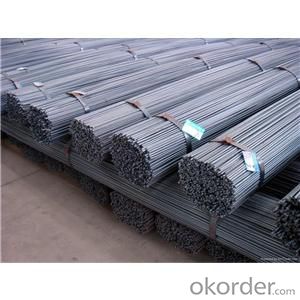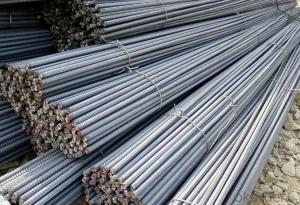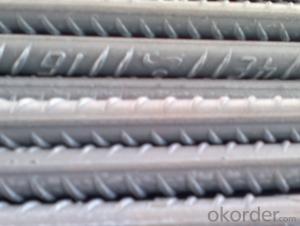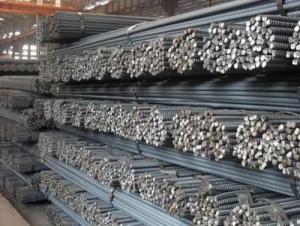Hot Rolled Carbon Steel Rebar 28mm with High Quality
- Loading Port:
- China Main Port
- Payment Terms:
- TT or LC
- Min Order Qty:
- 25 m.t.
- Supply Capability:
- 10000 m.t./month
OKorder Service Pledge
OKorder Financial Service
You Might Also Like
Product Description:
OKorder is offering Hot Rolled Carbon Steel Rebar 28mm with High Quality at great prices with worldwide shipping. Our supplier is a world-class manufacturer of steel, with our products utilized the world over. OKorder annually supplies products to European, North American and Asian markets. We provide quotations within 24 hours of receiving an inquiry and guarantee competitive prices.
Product Applications:
Hot Rolled Carbon Steel Rebar 28mm with High Quality is widely used in buildings, bridges, roads and other engineering construction. Big to highways, railways, bridges, culverts, tunnels, public facilities such as flood control, dam, small to housing construction, beam, column, wall and the foundation of the plate, deformed bar is an integral structure material. With the development of world economy and the vigorous development of infrastructure construction, real estate, the demand for deformed bar will be larger and larger..
Product Advantages:
OKorder's Hot Rolled Carbon Steel Rebar 28mm with High Quality are durable, strong.packed and suitable for construction
Main Product Features:
· Premium quality
· Prompt delivery & seaworthy packing (30 days after receiving deposit)
· Can be recycled and reused
· Mill test certification
· Professional Service
· Competitive pricing
Product Specifications:
Manufacture: Hot rolled
Grade: HRB335 HRB400 BS4449 Grade460 ASTM Grade40 Grade60
Certificates: ISO, SGS, BV, CIQ
Length:6m 8m 9m 12m
Packaging: Export packing, packed by coil
FAQ:
Q1: Why buy Materials & Equipment from OKorder.com?
A1: All products offered byOKorder.com are carefully selected from China's most reliable manufacturing enterprises. Through its ISO certifications, OKorder.com adheres to the highest standards and a commitment to supply chain safety and customer satisfaction.
Q2: How do we guarantee the quality of our products?
A2: We have established an advanced quality management system which conducts strict quality tests at every step, from raw materials to the final product. At the same time, we provide extensive follow-up service assurances as required.
Q3: How soon can we receive the product after purchase?
A3: Within three days of placing an order, we will begin production. The specific shipping date is dependent upon international and government factors, but is typically 7 to 10 workdays.
Q4: How many tons per bundle?
A4: Around 2-3tons
Q5: How to avoid the rust after deliver the goods to the loading port?
A5: We will keep the goods at the port covered with water-proof material
Q6: What is the chemical composition and physical properties of HRB400?
A6:
Grade | Technical data of the original chemical composition (%) | ||||||
C | Mn | Si | S | P | V | ||
HRB400 | ≤0.25 | ≤1.60 | ≤0.80 | ≤0.045 | ≤0.045 | 0.04-0.12 | |
Physical capability | |||||||
Yield Strength (N/cm²) | Tensile Strength (N/cm²) | Elongation (%) | |||||
≥400 | ≥570 | ≥14 | |||||
Images:


- Q:What are the different methods of connecting steel rebars?
- There are several methods of connecting steel rebars, including lap splicing, mechanical splicing, and welded splicing. Lap splicing involves overlapping the rebars and tying them together with wire or using mechanical anchoring devices. Mechanical splicing utilizes couplers or threaded sleeves to join the rebars together. Welded splicing involves welding the rebars together using electric arc or gas welding techniques. Each method has its own advantages and is chosen based on the specific requirements of the construction project.
- Q:How are steel rebars stored on-site?
- Steel rebars are typically stored on-site in a horizontal position, either on racks or on elevated platforms, to prevent contact with the ground and minimize the risk of corrosion. They are often organized by size and type, and protected from the elements through the use of waterproof covers or tarps. Additionally, rebars should be kept away from moisture and excessive heat to maintain their structural integrity.
- Q:Does the grade three thread steel with "E" have the same information price as the ordinary three grade thread steel? Is there a big difference?
- As far as I know, the price of information may not be divided into "E" and "E", but there are mandatory requirements on the standard. It is estimated that the price will not be much different.
- Q:Can steel rebars be used in structures with heavy dynamic loads?
- Structures with heavy dynamic loads can indeed make use of steel rebars. In reinforced concrete structures, steel rebars are commonly employed to enhance tensile strength and improve overall structural integrity. Their specific design enables them to withstand heavy loads, including dynamic ones caused by vibrations, earthquakes, or moving vehicles. The remarkable tensile strength of steel rebars allows for effective absorption and distribution of dynamic loads, effectively preventing structural failure or collapse. Moreover, steel rebars exhibit exceptional resistance to fatigue, thereby maintaining their strength and integrity even under repeated loading and unloading cycles. To ensure optimal performance under heavy dynamic loads, engineers take into account various factors, such as the size, shape, and spacing of rebars, as well as the quality of the concrete and the design of the structure itself. By meticulously designing and reinforcing the structure with steel rebars, it becomes possible to create a building that is both safe and durable, capable of withstanding heavy dynamic loads.
- Q:How are steel rebars protected during transportation and shipping?
- Steel rebars are typically protected during transportation and shipping through various methods such as bundling, wrapping, and using protective coatings. They are commonly bundled together using steel strapping or wire ties to prevent them from shifting or falling apart during transit. Additionally, rebars are often wrapped in plastic or paper to shield them from moisture, dust, and other external elements. Furthermore, some rebars may be coated with corrosion-resistant materials or painted to enhance their durability and prevent rusting. These protective measures ensure that steel rebars reach their destination in good condition, ready for use in construction projects.
- Q:How do steel rebars provide reinforcement to concrete?
- Steel rebars provide reinforcement to concrete by acting as tension members. When concrete is subjected to loads, such as the weight of a structure or external forces, it tends to crack and fail under tension. Steel rebars are embedded within the concrete to counteract this weakness. The rebars are made of high-strength steel, which has a much higher tensile strength than concrete. When the concrete is poured, the rebars are strategically placed throughout the structure, typically in areas where tension forces are expected to occur. This could include areas such as beams, columns, and slabs. As the concrete cures and hardens, it forms a strong bond with the steel rebars. When external forces are applied to the concrete, such as the weight of a building or lateral forces from wind or earthquakes, tension forces are generated within the concrete. However, instead of these forces causing the concrete to crack and fail, the rebars take on the majority of the tension. The high tensile strength of the steel rebars allows them to resist the tension forces, preventing cracks from forming and ensuring that the concrete remains intact and structurally sound. The rebars act as a reinforcement by distributing the tensile forces more evenly throughout the concrete, enhancing its overall strength and durability. Furthermore, rebars can also provide additional benefits to concrete structures. They can help minimize the effects of temperature changes, prevent shrinkage cracks, and improve the resistance to corrosion caused by exposure to environmental factors. Overall, the use of steel rebars in concrete construction significantly enhances the structural integrity and longevity of the concrete, ensuring its ability to withstand various loads and external forces over time.
- Q:Can steel rebars be used in historical building restoration?
- Yes, steel rebars can be used in historical building restoration. Steel rebars provide structural support and reinforcement, making them a suitable choice for strengthening and preserving historical buildings. However, careful consideration should be given to ensure that the use of steel rebars does not compromise the historical integrity and authenticity of the building.
- Q:Can steel rebars be used in pre-tensioned or post-tensioned structures?
- Yes, steel rebars can be used in both pre-tensioned and post-tensioned structures. In pre-tensioned structures, the rebars are tensioned before the concrete is poured, creating a compressive force in the concrete. In post-tensioned structures, the rebars are tensioned after the concrete has hardened, allowing for greater flexibility in design and reducing cracking.
- Q:What is the average lifespan of a reinforced concrete structure with steel rebars?
- The average lifespan of a reinforced concrete structure with steel rebars can vary depending on various factors such as design, construction quality, environmental exposure, and maintenance. However, with proper design, construction practices, and regular maintenance, reinforced concrete structures with steel rebars can typically last for several decades or even over a century.
- Q:How do steel rebars affect the overall sustainability certifications of a structure?
- Steel rebars can have a significant impact on the overall sustainability certifications of a structure. Firstly, the use of steel rebars in construction allows for increased structural strength and durability, which can enhance the lifespan of a building. This longevity reduces the need for frequent repairs or replacements, thereby reducing waste and resource consumption. Additionally, steel rebars can be recycled at the end of a structure's life, contributing to the circular economy and minimizing the environmental footprint. Moreover, steel rebars can help improve energy efficiency by enabling the use of thinner concrete sections, reducing the amount of material required and decreasing the embodied carbon footprint. Overall, incorporating steel rebars into construction practices can positively influence sustainability certifications by promoting resource efficiency, durability, and recyclability.
1. Manufacturer Overview |
|
|---|---|
| Location | |
| Year Established | |
| Annual Output Value | |
| Main Markets | |
| Company Certifications | |
2. Manufacturer Certificates |
|
|---|---|
| a) Certification Name | |
| Range | |
| Reference | |
| Validity Period | |
3. Manufacturer Capability |
|
|---|---|
| a)Trade Capacity | |
| Nearest Port | |
| Export Percentage | |
| No.of Employees in Trade Department | |
| Language Spoken: | |
| b)Factory Information | |
| Factory Size: | |
| No. of Production Lines | |
| Contract Manufacturing | |
| Product Price Range | |
Send your message to us
Hot Rolled Carbon Steel Rebar 28mm with High Quality
- Loading Port:
- China Main Port
- Payment Terms:
- TT or LC
- Min Order Qty:
- 25 m.t.
- Supply Capability:
- 10000 m.t./month
OKorder Service Pledge
OKorder Financial Service
Similar products
New products
Hot products
Hot Searches
Related keywords




























